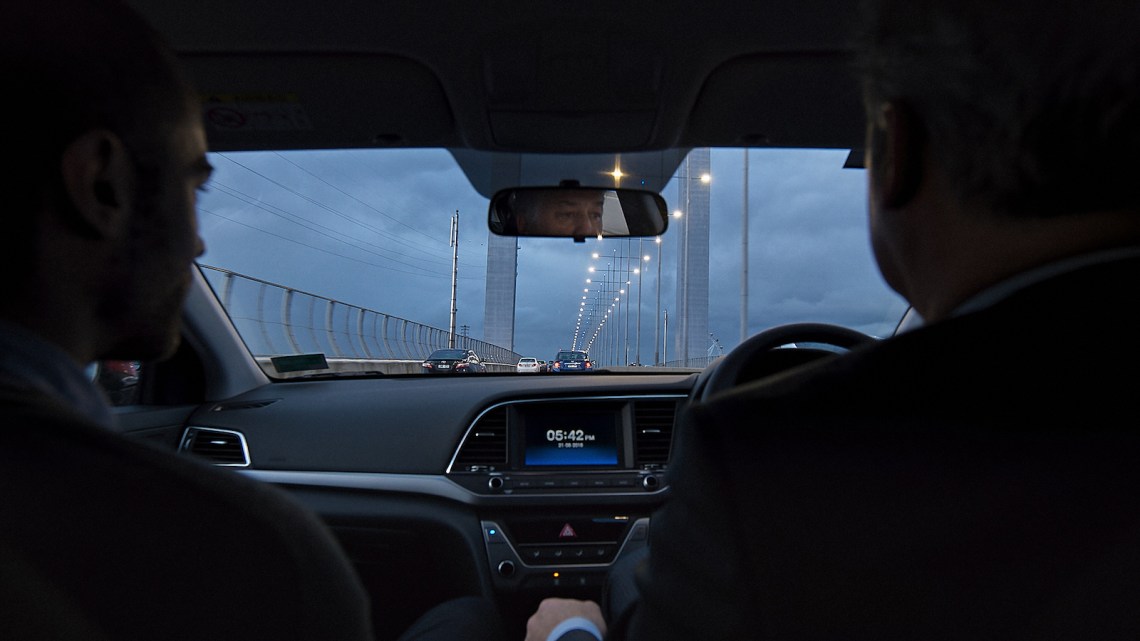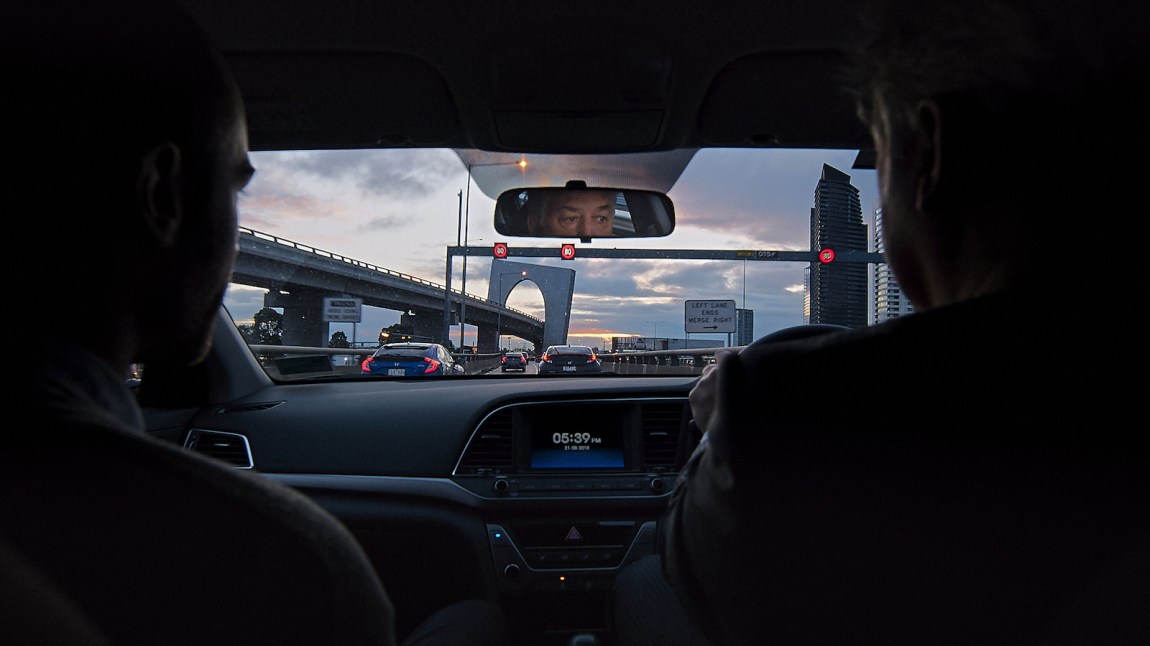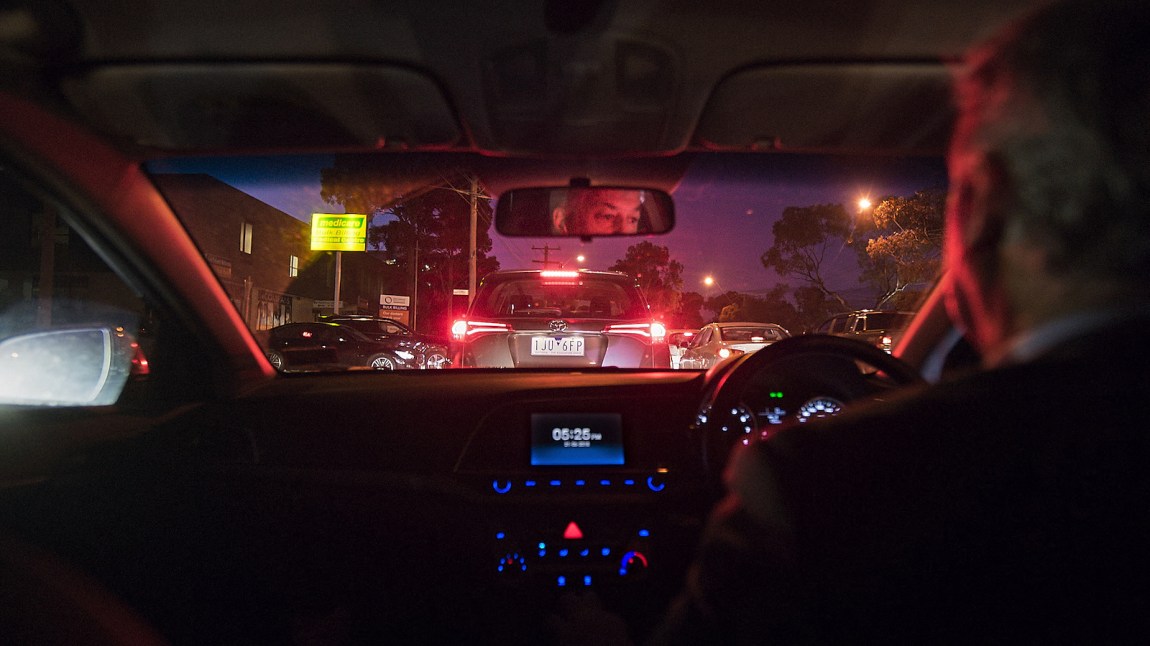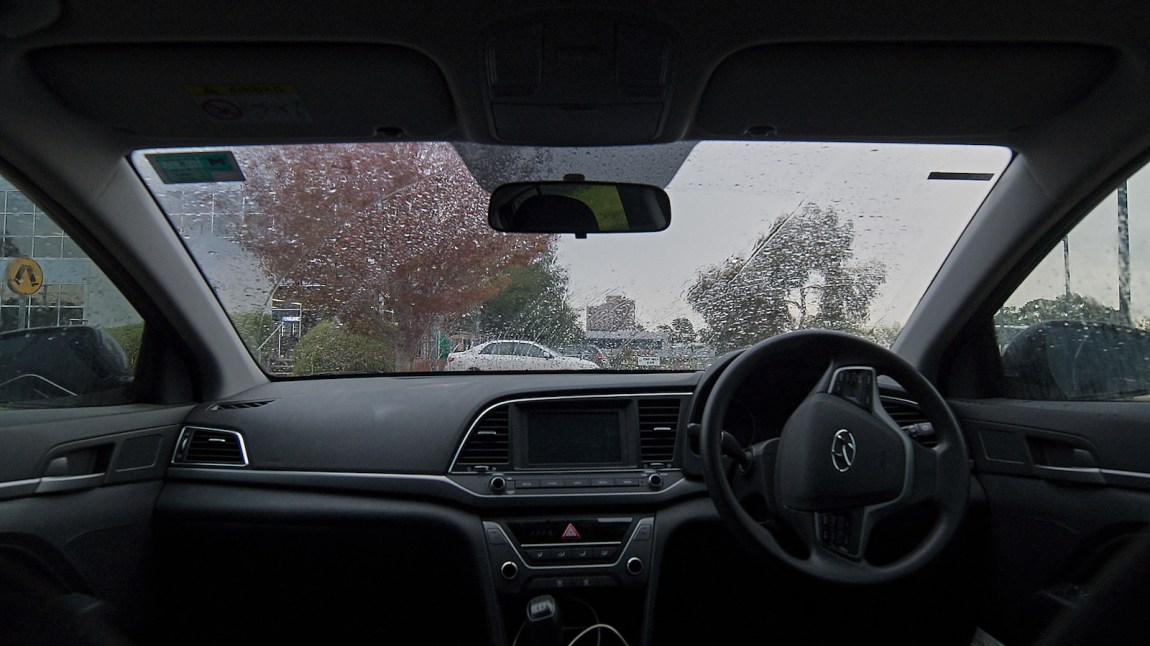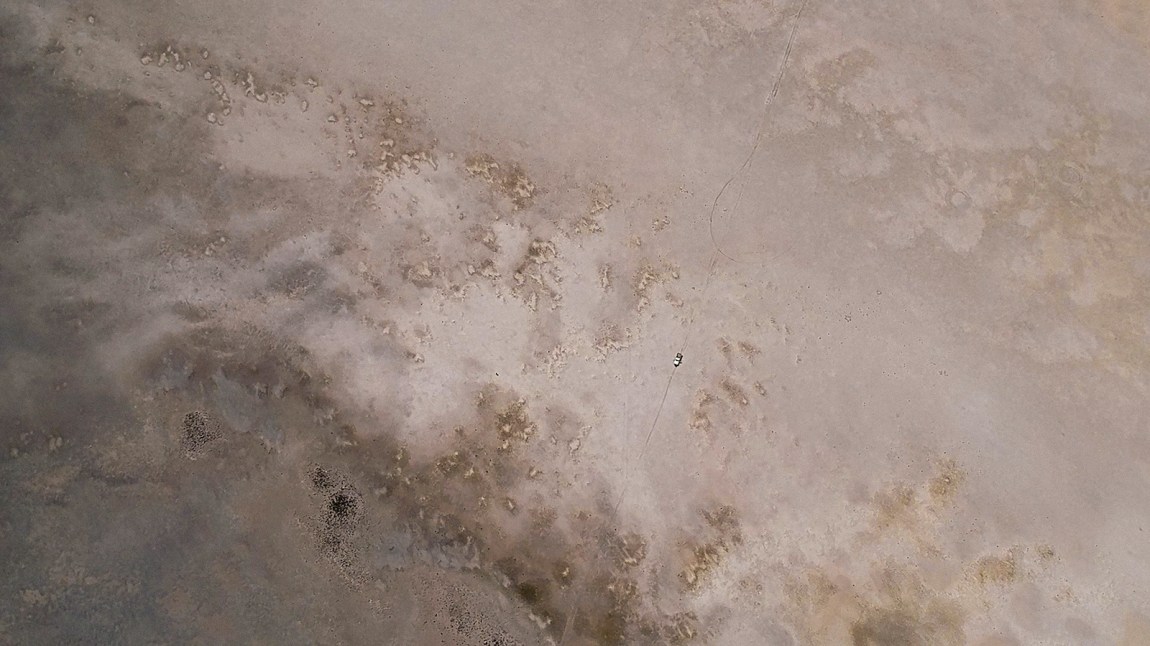We’ve been viewing the world from inside vehicles for more than a century. It’s no surprise, then, that people have been making films set inside cars, buses, and trains since the earliest days of cinema, when the public would pay to see “phantom rides,” footage from a camera set at the front of a vehicle as it moved through city streets. Part of the popularity of this form came from recognition: people wanted to see their own city, its landmarks, and even perhaps themselves.
I was thinking of those phantom rides when I watched David Easteal’s The Plains, a three-hour-long film from last year shot almost entirely from the back seat of a car. The Plains is the latest in a subgenre of feature-length narrative films set in cars, such as Abbas Kiarostami’s Taste of Cherry (1997), Steven Knight’s Locke (2013), Jafar Panahi’s Taxi Tehran (2015), and Ryusuke Hamaguchi’s Drive My Car (2021). What makes Easteal’s film different from these recent features is that the camera remains static throughout, so we see only the backs of the driver’s and passenger’s seats and the road through the windshield. The film takes place over a series of homeward commutes taken by Andrew (Andrew Rakowski), a middle-aged lawyer, into Melbourne from his workplace in the suburbs. Andrew occasionally gives a lift to his younger colleague, David (played by Easteal), and the two men develop a friendship. The film is, in this sense, a reenactment: Easteal is also a barrister, and he and Rakowski are former colleagues at a law firm; the film restages carpool commutes they once made together, each of them playing versions of themselves. Over the course of the film we learn about Andrew’s marriage, his sick mother, his second house between Melbourne and Adelaide, and the history of his family.
The phantom ride of early cinema produced a thrill in the viewer partly because of the novelty of automated transport itself. The twenty-first-century commute is a different matter. Unlike the changing city vistas of the phantom ride, much of The Plains is spent in traffic, the windshield obscured by static vehicles on Melbourne’s notoriously clogged roads. (I once drove through the city’s downtown to get to the airport, an experience I never wish to repeat.) The car is where we have the most sustained periods of stillness and silence in our day, but it’s also a space where we’re acutely aware of time passing, either because we don’t want to be late or because we want to get home. Throughout Easteal’s film there is a digital clock at the center of the dashboard and thus in the center of the frame. Our hyperawareness of the minutes passing is set against another, larger set of temporal markers; from the levels of sunlight and the rhythms of traffic, we can see the seasons change.
The Plains is far from the first film to depict everyday activities in real time. In Laura Mulvey and Peter Wollen’s Riddles of the Sphinx (1977), to take one example, the rhythms of a woman’s domestic labor, including a car ride, are played out in a series of 360-degree panning shots. By marginalizing the visual presence of their female characters and foregrounding the sound of their voices instead, Mulvey and Wollen sought to resist the cinematic objectification of women; character, here, is less important than the disruption of a form to which we have become accustomed, and the durational shots distance the audience from our visual and emotional identification with the leads. Later, daylong films such as Douglas Gordon’s 24 Hour Psycho (1993) or Christian Marclay’s The Clock (2010), in which material from existing movies is stretched out or stitched together to vast length, more directly emphasize time itself, making viewers acutely aware of their temporal position in a narrative that outlasts their ability to experience it all at once.
What’s different about The Plains is that it marries these durational and clock-bound forms to an emotionally plainspoken narrative. The film’s use of the dashboard clock allows the viewer to see the amount of time that the commutes, which run from a few minutes to around half an hour, are taking. This gives the film an accretive power; the enclosed, time-bound scene of the car paradoxically becomes a place where the lives of the two men are permitted to flow freely, these accumulating slices of time allowing them to open up to each other or simply be together. The film’s considerable length is important, because it affords long sequences of silence that communicate the emotional weather of the passengers as much as their conversation.
Also crucial is the position of the camera itself. Watching The Plains I found myself thinking of the framing and montage techniques used by Yasujirō Ozu, who often situated the camera lower than the sightlines of his characters. Ozu cuts between actors in profile and shots where they look directly into the camera, and when characters talk to one another, we often see their bodies, one at a time, in separate shots. Easteal retains that low-situated shot composition in The Plains, but a car requires its passengers not to face each other, and in The Plains the viewer barely sees either actor’s face at all. Only once, late in the film, does the camera move into the front seat and we see Andrew glance toward the lens.
Advertisement
It’s precisely this apparent lack of intimacy that makes communication possible. Andrew feels able to share increasingly personal details of his life with David in part because he doesn’t have to look directly at him. In the world outside the car, which is mediated through the men’s anecdotes or phone calls, problems of miscommunication proliferate: Andrew’s boss accuses him of lacking the ability to interact with her; his phone calls with his wife, Cheri, are often truncated, either because of David’s presence in the car or because Andrew calls at an inconvenient time; and he holds a series of increasingly difficult phone conversations with his mother, who is in the advanced stages of dementia.
When there is miscommunication inside the car, it tends to be, as in Ozu’s work, intergenerational. Andrew, a baby boomer with a second home, can’t understand why David, a millennial, hasn’t yet bought a house, and his long marriage contrasts with David’s use of Tinder. The view from the back seat, and the height at which the camera is positioned, might also imply the phantom presence of a child. Andrew reveals that he and Cheri never had children, and the economic precarity of David’s position, not to mention the car radio’s occasional references to climate change, and indeed the planet-killing traffic that constantly clogs the frame, complicate the prospects of a new generation.
The Plains does not take place entirely within the car. Occasionally Easteal cuts to drone footage of the titular landscape, shot by Andrew on his rural estate. The incongruity is so sharp that the first time it happened I literally gasped; we’ve been plucked out of the vehicle in which we’ve been buried, our horizon endlessly blocked by traffic, and flung upward into the sky. Now we perceive Andrew’s car as a dot, hundreds of feet below, almost invisible in the expanse of the landscape. Over the footage we hear Andrew’s voice, and we realize with a lurch that we’re not actually in the air but viewing the footage as he is watching it on an iPad. Later, in the car, Andrew hands David the iPad, and David scrolls through some of the footage we’ve seen earlier, the hugeness of the plains relegated to a small screen that is itself positioned below the vista of the car’s windshield.
In this moment we are viewing three screens simultaneously: iPad, windshield, film frame. The complexity of these nested viewing positions feels a long way from the simple thrills of the phantom ride, but this, I think, is part of Easteal’s point. In early cinema, the moving vehicle was itself an entertainment. In the time since, and with the accompanying crowding of our lives with the traffic of mediated images, the frame has been filled with distractions and necessities. The formal simplicity of the silent phantom ride is long gone. But there is something in this ever more static space that allows a new form of emotional communication to bloom.
Toward the end of the film, David’s decision to take work elsewhere raises the possibility that the friendship we’ve been watching might be limited to these moments of time carved out of the working day. The dashboard clock that has counted the minutes spent in traffic now counts down the remaining time that the two men will spend together. Was this simply a friendship of convenience or something longer lasting? The silences between them, once signs of awkwardness and later comfort, now indicate time that will eventually run out. Easteal’s film doesn’t offer anything like catharsis; the lives of these men are bound to the rhythms of things—work, careers, traffic—that are larger than themselves. Whether the relationship survives or not, the film suggests, these rhythms will continue, the camera’s steady eye watching, unmoved, remorseless, from the back seat.


